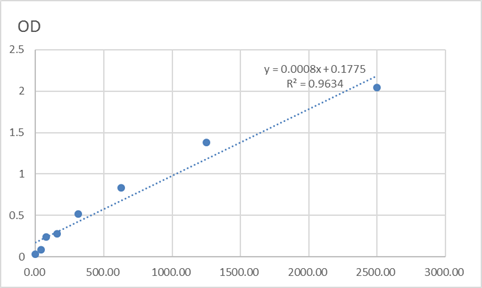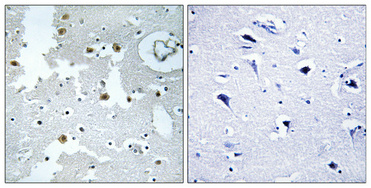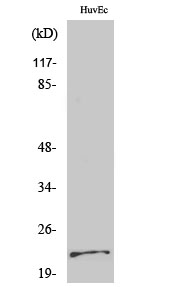Total PARK7 Cell-Based Colorimetric ELISA Kit
- Catalog No.:KA3242C
- Applications:ELISA
- Reactivity:Human;Mouse
- Gene Name:
- PARK7
- Human Gene Id:
- 11315
- Human Swiss Prot No:
- Q99497
- Mouse Swiss Prot No:
- Q99LX0
- Storage Stability:
- 2-8°C/6 months
- Other Name:
- Protein DJ-1 (EC 3.4.-.-) (Oncogene DJ1) (Parkinson disease protein 7)
- Detection Method:
- Colorimetric
- Background:
- disease:Defects in PARK7 are the cause of autosomal recessive early-onset Parkinson disease 7 (PARK7) [MIM:606324, 168600]. Parkinson disease (PD) is a complex, multifactorial disorder that typically manifests after the age of 50 years, although early-onset cases (before 50 years) are known. PD generally arises as a sporadic condition but is occasionally inherited as a simple mendelian trait. Although sporadic and familial PD are very similar, inherited forms of the disease usually begin at earlier ages and are associated with atypical clinical features. PD is characterized by bradykinesia, resting tremor, muscular rigidity and postural instability, as well as by a clinically significant response to treatment with levodopa. The pathology involves the loss of dopaminergic neurons in the substantia nigra and the presence of Lewy bodies (intraneuronal accumulations of aggregated proteins), in surviving neurons in various areas of the brain. PARK7 is characterized by onset before 40 years, slow progression and initial good response to levodopa.,disease:Defects in PARK7 influences susceptibility to amyotrophic lateral sclerosis-parkinsonism/dementia complex type 2 [MIM:105500]; also called amyotrophic lateral sclerosis-parkinsonism/dementia complex of Guam or Guam disease. Amyotrophic lateral sclerosis-parkinsonism/dementia complex type 2 is a neurodengenerative disorder with unusually high incidence among the Chamorro people of the Western Pacific Islands of Guam. Both amyotrophic lateral sclerosis and parkinsonism-dementia are chronic, progressive, and uniformly fatal disorders in this population. Both diseases are known to occur in the same kindred, the same sibship, and even the same individual.,function:Acts as a positive regulator of androgen receptor-dependent transcription. May function as a redox-sensitive chaperone and as a sensor for oxidative stress. Prevents aggregation of SNCA. Protects neurons against oxidative stress and cell death. Plays a role in fertilization. Has no proteolytic activity. Has cell-growth promoting activity and transforming activity.,induction:By ultraviolet irradiation.,miscellaneous:Cys-106 is easily oxidized to sulfinic acid.,online information:The Singapore human mutation and polymorphism database,PTM:Sumoylated on Lys-130 by PIAS2 or PIAS4; which is enhanced after ultraviolet irradiation and essential for cell-growth promoting activity and transforming activity.,similarity:Belongs to the peptidase C56 family.,subcellular location:Associated with mitochondria in some cells, particularly after oxidative stress. Detected in tau inclusions in brains from neurodegenerative disease patients.,subunit:Homodimer. Binds EFCAB6/DJBP and PIAS2. Part of a ternary complex containing PARK7, EFCAB6/DJBP and AR.,tissue specificity:Highly expressed in pancreas, kidney, skeletal muscle, liver, testis and heart. Detected at slightly lower levels in placenta and brain. Detected in astrocytes, Sertoli cells, spermatogonia, spermatids and spermatozoa.,
- Function:
- response to reactive oxygen species, neurotransmitter uptake, regulation of neurotransmitter levels, synaptic transmission, dopaminergic, oxygen and reactive oxygen species metabolic process, neurotransmitter transport,cellular ion homeostasis, response to oxidative stress, intracellular signaling cascade, small GTPase mediated signal transduction, Ras protein signal transduction, cell-cell signaling, synaptic transmission, nerve-nerve synaptic transmission, behavior, locomotory behavior, adult locomotory behavior, response to inorganic substance, amine transport, monoamine transport, organic alcohol transport, dopamine transport, transmission of nerve impulse,cellular homeostasis, adult behavior, regulation of membrane potential, response to drug, response to hydrogen peroxide, homeostatic process, hydrogen peroxide metabolic process, chemical homeostasis, ion homeostasis,neurological s
- Subcellular Location:
- Cell membrane ; Lipid-anchor . Cytoplasm . Nucleus . Membrane raft . Mitochondrion . Endoplasmic reticulum . Under normal conditions, located predominantly in the cytoplasm and, to a lesser extent, in the nucleus and mitochondrion. Translocates to the mitochondrion and subsequently to the nucleus in response to oxidative stress and exerts an increased cytoprotective effect against oxidative damage (PubMed:18711745). Detected in tau inclusions in brains from neurodegenerative disease patients (PubMed:14705119). Membrane raft localization in astrocytes and neuronal cells requires palmitoylation. .
- Expression:
- Highly expressed in pancreas, kidney, skeletal muscle, liver, testis and heart. Detected at slightly lower levels in placenta and brain (at protein level). Detected in astrocytes, Sertoli cells, spermatogonia, spermatids and spermatozoa. Expressed by pancreatic islets at higher levels than surrounding exocrine tissues (PubMed:22611253).
- June 19-2018
- WESTERN IMMUNOBLOTTING PROTOCOL
- June 19-2018
- IMMUNOHISTOCHEMISTRY-PARAFFIN PROTOCOL
- June 19-2018
- IMMUNOFLUORESCENCE PROTOCOL
- September 08-2020
- FLOW-CYTOMEYRT-PROTOCOL
- May 20-2022
- Cell-Based ELISA│解您多样本WB检测之困扰
- July 13-2018
- CELL-BASED-ELISA-PROTOCOL-FOR-ACETYL-PROTEIN
- July 13-2018
- CELL-BASED-ELISA-PROTOCOL-FOR-PHOSPHO-PROTEIN
- July 13-2018
- Antibody-FAQs



